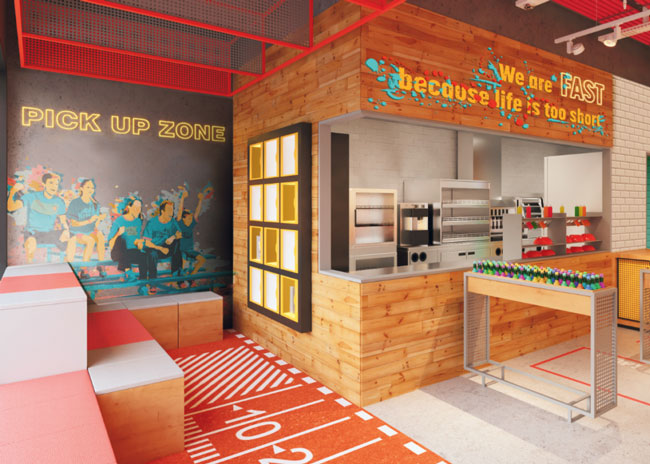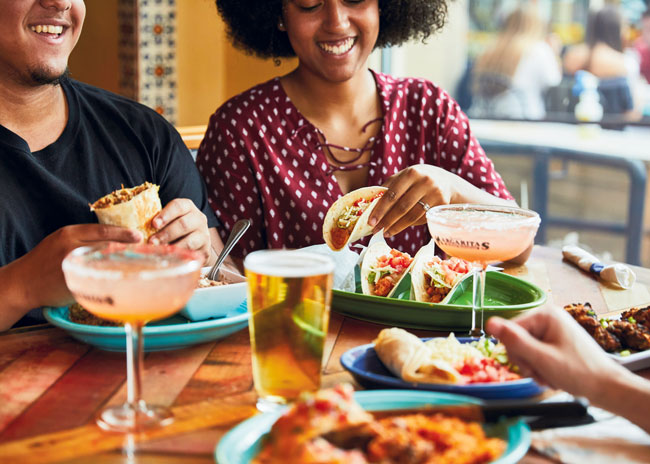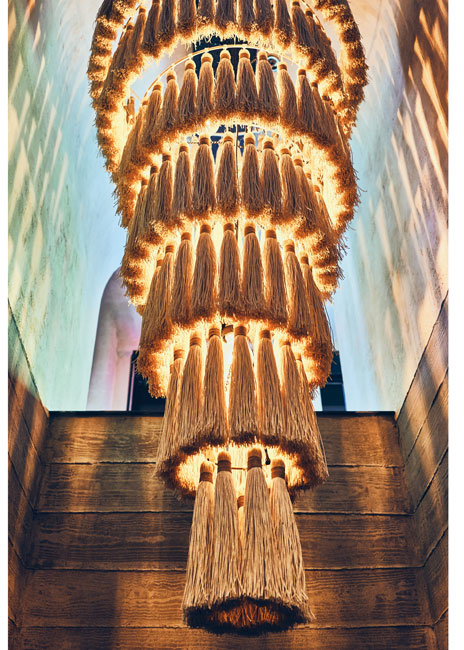The last two years have brought major disruptions to the restaurant and foodservice industry —for better or for worse.
A pandemic-induced shutdown of indoor dining nationwide forced restaurants to shift to takeout and delivery — some for the first time ever. Outdoor patios, hastily constructed out of tents and heaters, now have become permanent fixtures. Menus are tighter. Staffs are smaller. Kitchens are smarter — or, at least, they’ll need to get smarter.
“We’re in a bit of a wild, Wild West in terms of where the industry is going,” says David Bloom, chief development and operations officer of the quick-serve Wing Zone and Capriotti’s Sandwich Shop, two chain restaurants that merged in early 2021. “This is a great opportunity for brands that are nimble and think outside of the box, but it’s also disruptive for brands not prepared to do that.”
For Wing Zone, “being nimble” meant dumping the idea of a fixed design prototype altogether in order to adapt to the times, year after year. The team worked with Madrid-based design firm Livit to rethink all aspects of the operation, including design and equipment, to focus on the customer experience first and foremost. The kitchens at both Wing Zone and Capriotti’s locations were opened up further with more equipment moved up front so diners can see the wings cooking or turkey being roasted. The refresh even included a “scent strategy” meant to push delicious smells to the front of the house, as well as a custom-curated playlist that guests can enjoy on their own by scanning a QR code with their phone.
While front-of-the-house adaptations continue, these shifts also connect to four new back-of-the-house trends that support the modern restaurant.
 In addition to providing guests a look into the kitchen, Wing Zone’s newest prototype includes cubbies where the chain places orders for both on-premises and off-premises guests.
In addition to providing guests a look into the kitchen, Wing Zone’s newest prototype includes cubbies where the chain places orders for both on-premises and off-premises guests.
1. Electric (and Fire)
“Electric cooking is going to be huge,” says Stuart Davis, vice president of Next Step Design’s Midwest Division. The company designs kitchens primarily for fine-dining restaurant clients across the country and in California, where he says new laws are pushing out gas in new buildings in favor of electric.
Davis notes that electric kitchens go beyond just the use of induction burners everywhere. “Most cooklines in Europe are electric, so we’re seeing the adoption of more full-suite electric cooking like that here,” he says.
“This will change the way chefs cook,” says Davis, a former chef himself. As a consultant, he’s had to adapt his kitchens to have larger circuit and breaker panels.
Ryan Mikita, FCSI associate, principal, Ricca Design Studios, says he’s also seeing the rapid growth of electric equipment. “Induction cooking is modular in nature, so you can create a more flexible space,” he says. “Rather than have a 20-foot, linear food production hood with a mix of gas and electric equipment underneath it, you can accomplish the same thing in 15 feet by using all induction and electric equipment because the mechanical size is smaller. This has been around in Asia and Europe for at least a decade.”
While traditionally chefs have preferred gas, “You actually have more control over the cooking [with electric] because you have more even and consistent heat that’s concentrated right under the surface,” Mikita says. “There are a lot of myths and misnomers in the industry about electric, so it will take a couple years to catch on.” Another issue is that some of the electricity in this country is still produced by solid fuel, he adds, so the infrastructure isn’t there just yet.
The growing interest in hoodless or ventless equipment comes into play in the electric discussion. “Ventless equipment has its advantages, especially in renovation projects because it allows you to retrofit a space easier,” Mikita says. Not to mention, he adds, induction or electric kitchens improve the work environment because they reduce ambient heat in the kitchen. That will be more important in the future as people consider jobs in foodservice.
Davis says that with electric, there’s been some struggle to replace charbroilers. That’s why many of his chef clients still want live fire in their restaurants if they’re using electric elsewhere. “Hearth cooking is not going away any time soon,” he says. “But wood burning has its own complexities.”
What’s made investing in wood-burning equipment more appealing to restaurateurs is the fact that there are smaller pieces out on the market. “You don’t have to buy a huge piece anymore. There are petite grills now — we put one in that’s just three feet wide in a hotel in Fargo,” Davis says. While wood-burning equipment does carry its own hood and ventilation requirements, chefs love them because they become part of the dining experience and can be used to cook lots of different types of food. “If gas is going away, you can still have a combination of fire and electric,” he says.
When it comes to electric kitchens, ghost kitchens, technologically enhanced kitchens or otherwise, all of these “trends” were in the works for years, says David Tracz, partner at the Washington, D.C.-based design and architecture firm //3877. “The pandemic really pushed all these things up front. And now they’re all here to stay,” he adds.
2. Off-Premises Food Production and Pickup Areas
More than half of casual-dining (52%) and fine-dining (54%) restaurant operators said they have devoted more resources to expanding off-premises business since the initial COVID-19 shutdown in March 2020, according to the National Restaurant Association’s 2021 “State of the Industry” report. The sales of off-premises food spoke higher volumes: 74% of fast-casual and quick-serve establishments reported higher sales coming from off-premises food, followed by 70% of casual-dining, 69% of family-dining and 63% of fine-dining establishments reporting the same. The people have spoken too: A majority of adults across multiple generations, including Gen Z (62%), Millennials (73%), Gen X (68%) and Baby Boomers (67%) today say they’re more apt to purchase takeout or delivery from restaurants than before COVID-19 hit.
This shift in consumer preference directly impacts restaurant design. “Delivery and takeout are definitely here to stay across the board,” says Tracz. “The key for most restaurants is to figure out how to provide a separate space or, in some cases, even a separate entrance to handle takeout. No one wants to see a bunch of bags labeled Uber and Grubhub piled up at the host stand or on a table somewhere. Our goal [as architects] is to make [these areas] look more like a decorative element while also remaining functional.”
For Margaritas Mexican Restaurant Group, a full-service, franchised restaurant group founded in 1986 with 25 locations throughout Massachusetts, Maine, New Hampshire, Connecticut, New Jersey and Pennsylvania, the shift to delivery and takeout forced execs to rethink and redesign expo stations in the back of the house. “We do have limitations because all of our locations are so different, but we’re working on more permanent solutions for the future,” says Bob Ray, chief operating officer. “We’re developing new curbside pickup programs and thinking about how to create more user-friendly pickup areas near the host stand.”
While the takeout situation may be trickier for full-service restaurants like Margaritas that focus more on aesthetics and on-site dining, quick-serve and fast-casual operators are quickly gobbling solutions for creating takeout spaces — be it cubbies, heated shelves or other options.
While Capriotti’s uses cubbies only for takeout and delivery orders, sibling concept Wing Zone now places every order — takeout or not — in the cubbies, says Bloom. Staff package and arrange orders alphabetically by customer name in the cubbies, which have heated shelves to keep the food warm. A screen above notifies the customers when their food is ready so they don’t have to stand there digging around for their bag.
“Everything has to be integrated for this to work,” says Bloom, who notes that all of the ordering methodologies — third-party delivery sites, online and brand apps, in-store kiosks, QR codes and staff-manned POS stations — go straight to kitchen display units in real time. Bloom says he wouldn’t be surprised to see the technology extended to self-driving vehicles in the future as delivery capabilities expand.
 Margaritas Mexican Restaurant Group dropped lunch service to focus on its most profitable dayparts: dinner and late night, which often include the chain’s signature drink, the margarita.
Margaritas Mexican Restaurant Group dropped lunch service to focus on its most profitable dayparts: dinner and late night, which often include the chain’s signature drink, the margarita.
3. Labor-Saving Equipment, Automation and Robotics
“The Great Resignation” of 2021 and the rash of workers leaving the hospitality industry pushed restaurateurs to think outside the box to maintain their volumes amid labor shortages.
Many operators pared down their menus to cut both food and labor costs as well as to deal with shifting supply chain issues. That was certainly the case for Margaritas Mexican Restaurant Group, which dropped its lunch service at just about all of its locations to focus on dinner only. “The shutdown gave us a chance to better evaluate how to run our concept,” says Ray. “We are a scratch kitchen, but over the years, there was some menu creep, and that translated to more labor in terms of prep work as well as a larger equipment package and need for a bigger hood.”
By shrinking the menu, cross-utilizing ingredients and zeroing in on only the most profitable daypart, Ray says the restaurant group has been able to operate more efficiently, even with a smaller staff. The chain’s overall restaurant space has shrunk as well — any new builds will encompass around 5,000 square feet as opposed to 7,500, creating a need for even more efficiency in the front and back of the house.
The adoption of advanced ordering, ticket, reservation and scheduling management solutions has also helped Margaritas better manage its staff, Ray says. Tracz suggests utilizing new systems will definitely be necessary for all types of restaurants in the future. “We could see a lot more QR code ordering where you don’t really have a server taking orders or even handling payment; you have runners and a server who’s just focused on the customer experience,” says Tracz.
Some of these software applications continue to make their way to the back of the house to further enhance management functions and address labor issues. “Technology and equipment are going to continue to take a greater role in operating restaurants,” says Mark Moeller, a former chef and owner Recipe of Success, a restaurant consultancy. “There’s a lot of unskilled labor now coming into the industry, so there’s an opportunity to use robotics and programmable pieces to ensure consistency.”
Moeller points to the growth of programmable, multiuse combi ovens as well as clamshell griddles that can cook food in minutes without a lot of oversight. Once reserved mainly for the noncommercial sector, blast chillers are having a heyday in the restaurant scene. “My last five clients all have blast chillers, and I keep getting requests,” he says. “Many smaller restaurants don’t have the facility or space to properly cool food to safe temperatures.”
Rather than having staff constantly stirring a bucket of soup with a frozen paddle — or worse, shoving a steaming container in a walk-in cooler — the smaller-scale blast chillers now available offer managers peace of mind in terms of food safety. Not to mention, as the food supply chain ebbs and flows, restaurants can use blast chillers to cook and/or preserve certain ingredients or foods that might be hard to come by later on (e.g., certain beef products, bacon, even seasonal vegetables).
Erica Holland-Toll, culinary director at The Culinary Edge, a restaurant consultancy, also believes robotics and other forms of automation will be the wave of the future. “I’ve already seen food stalls run by robots, and we’ve seen them for years in hospitals,” she says. “If you think about hospitals and a college campus, it’s tough to staff those graveyard shifts. I wouldn’t be surprised to see the growth of things like ramen machines and salad robots in that case.”
There’s also room for this automation in traditional restaurants. “[Robots] can handle mundane tasks like frying wings and flipping burgers. I can see them becoming more ubiquitous as investment [in them] grows and the labor pool shrinks,” Holland-Toll says.
The leadership team at Wing Zone and Capriotti’s has already jumped on the robotics train. “At Capriotti’s, we use artificial intelligence cameras that study the grill and how the cheesesteaks are being made so we can eventually have it done by a robot,” Bloom says. A robotic arm for the frying station is currently being tested for Wing Zone. “We want to automate as many mundane tasks as we can because nobody can find enough people to run a restaurant, and that’s likely not changing. When you go to the airport, you don’t see 25 gate agents anymore; you see more self-serve kiosks. If some of the work in the restaurant is being handled by a robot, then our staff can talk to customers and have a more personal interaction. This enhances the customer experience.”
Bloom adds that the employees at the locations testing the robotic frying arm have said they like the addition because they don’t have to “sit over a hot fryer all day.”
4. Commissary (and Ghost or Virtual) Kitchens
By now, you’re probably sick of hearing about ghost kitchens, but be prepared to hear different terms and iterations in the future that essentially point to the same thing: the idea that restaurants can use a commissary or arrange kitchen space to make room for higher-volume cooking with less labor, delivery-only food production, expanded catering and/or multiple revenue stream-building.
“Kitchens have always gotten squeezed, but more than ever now the cost per square footage is going up, and it’s getting harder than ever to properly size a kitchen with conventional methods,” says Mikita. “What’s happening is a need to think outside of the box when creating new concepts.” In this case, literally.
Mikita recently worked with a restaurant in California that was hesitant to expand their market. “So, rather than opening a full-blown restaurant during the pandemic 100 miles west, they bought a storefront not in use and put a ghost kitchen in it to offer delivery and takeout in that new area,” he explains. “As revenue started to come in and they built a new customer base, they remodeled and turned it into a restaurant from there.” This is “one clever way” restaurants can expand their reach with low risk without necessarily becoming delivery-only forever, Mikita notes.
Incubator or shared kitchens also play a growing role in restaurant management and development. “Fledging brands can rent some of the space to test menus and start offering food in a certain market through delivery or catering,” Mikita says. “It’s another low-risk model for them.”
Holland-Toll has also seen growth in the merging of two or more brands in the same kitchen space. For example, Inspire Brands, the parent company of Dunkin’, Baskin-Robbins, Arby’s, Buffalo Wild Wings, Jimmy John’s, Sonic Drive-In and Rusty Taco, last year launched Alliance Kitchen, a ghost kitchen that allows customers to order delivery from all seven brands via one brand’s online ordering platform or third-party apps.
“I’m also seeing this at a smaller scale in the Bay Area, with some restaurants producing different menus in the same shared space and being able to really double down on the inventory available,” Holland-Toll says. “I could see more of these kitchens even catering to the delivery drivers, with coffee machines, water-filling stations and restrooms.”
Moeller says commissaries, shared, virtual or ghost kitchens — call them what you will — also help restaurants streamline operations and ensure consistency. “We’re building a commissary right now for a client who has four Greek restaurants, and they had a product being made eight different ways for those four restaurants,” he says. “With the commissary, we’ll be able to centralize 65% of the menu development out of one kitchen, so all the food is always prepared the same way.”
The use of a commissary can also help restaurants get better pricing on food and streamline deliveries. “If you grill 1,000 pounds of chicken a week, with a consolidated kitchen, you can buy 1,500 pounds to have a little extra at one shot and have it delivered to one place rather than just buying 200 or 300 pounds here or there,” Moeller adds. “Now you have economies of scale.”
Front of the House Trends
 Image courtesy of Zeph ColombattoDavid Tracz, partner at //3877, a Washington, D.C.-based architecture and design firm, shares his thoughts on what’s trending in restaurants when it comes to front-of-the-house and seating design.
Image courtesy of Zeph ColombattoDavid Tracz, partner at //3877, a Washington, D.C.-based architecture and design firm, shares his thoughts on what’s trending in restaurants when it comes to front-of-the-house and seating design.
Lighting: Today’s LED lights offer more warmth and dimming capabilities than ever before.
Custom millwork: Concrete, steel and industrial materials and fixtures have given way to a rise in natural woods and even luxury vinyl tile meant to look like wood.
Compartmentalized seating: Rather than create permanent dividers, breaking up the dining area by using different types of seating and flow can help create more private areas as well as areas that can be closed off when not in use.
More greenery: Now that consumers are more used to and even prefer dining outdoors, designers are looking to bring a bit of the outdoors back inside for that natural look and energizing feel.
Outdoor: Permanent heaters and seating as well as roll-up doors, windows and roofs that protect against the elements have replaced makeshift tents from the pandemic.



